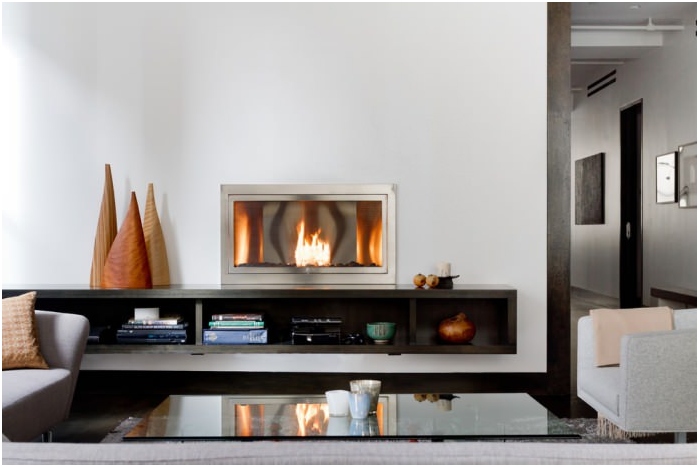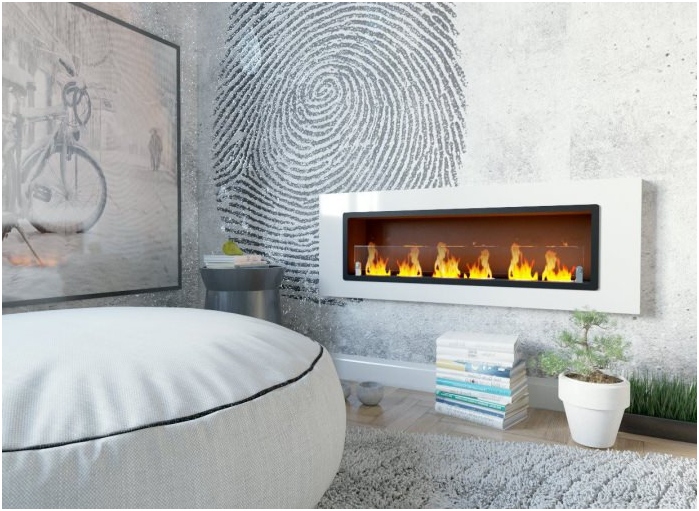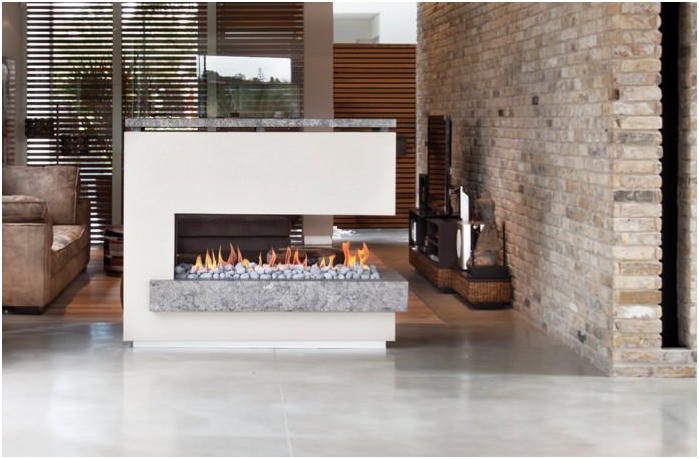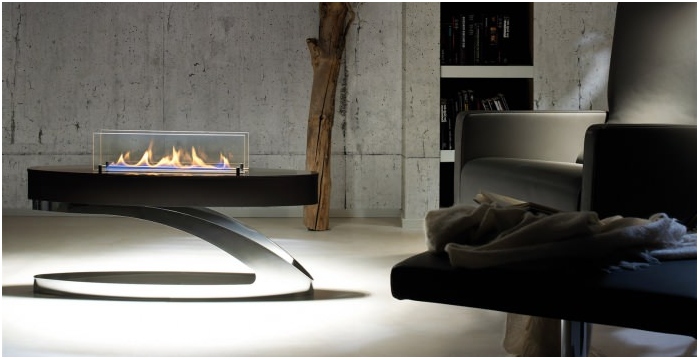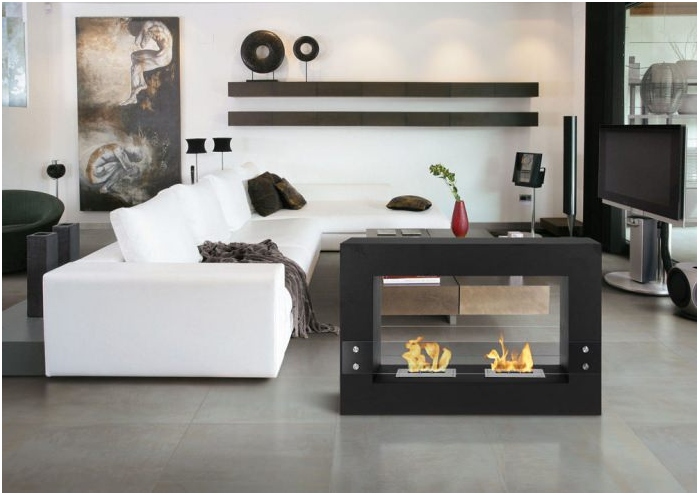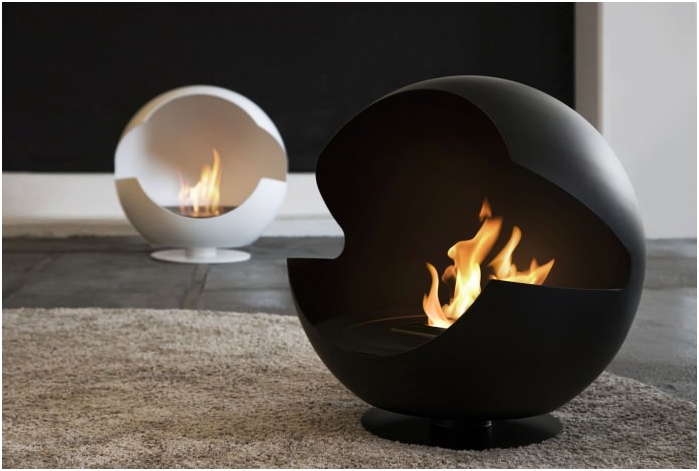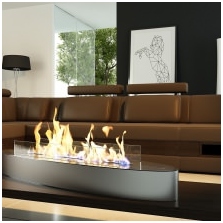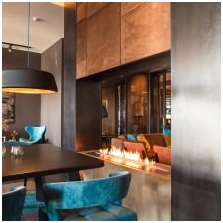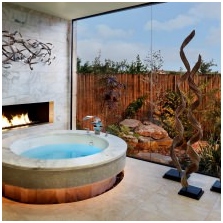A bio-fireplace in the interior of any apartment does not take up much space, does not require a chimney and a supply of firewood, and at the same time can bring an atmosphere of warmth and comfort into it. Increasingly, biofireplaces are also used in private houses, cottages, as they do not require expensive preparation for installation and labor-intensive maintenance. Bio fireplaces are of different types, and it is necessary to determine exactly which one is right for you.
Bio fireplace device
Any biofireplace is a device consisting of separate elements:
- portal (body) – protects against contact with heating parts of the structure, and also performs decorative functions;
- burner – depending on the biofireplace device, it can have a different design, but it is always an element in which the fuel is burned;
- ferlector – regulator of power supply of heat air flow and its direction;
- door – protects against direct contact with the flame, can be made of various materials, including glass.
One of the main advantages of a bio fireplace is that there is no need for a chimney, so it can be placed anywhere in the room. This fireplace got its name from the type of fuel: it uses fuel of biological origin, most often bioethanol. It would be more correct to call bio fireplaces “smokeless” fireplaces. Do not confuse them with electric ones: the latter give heat, but there is no real, living fire in them..
In biofireplaces, the fire is real, and from the usual “real” fireplaces they differ in that the fuel burns in them without the release of smoke, as well as toxic gases – the combustion products of bioethanol are water and carbon dioxide, which do not harm the environment and humans. In addition, after the combustion of biofuel, no ash remains, which facilitates the care of the biofuel.
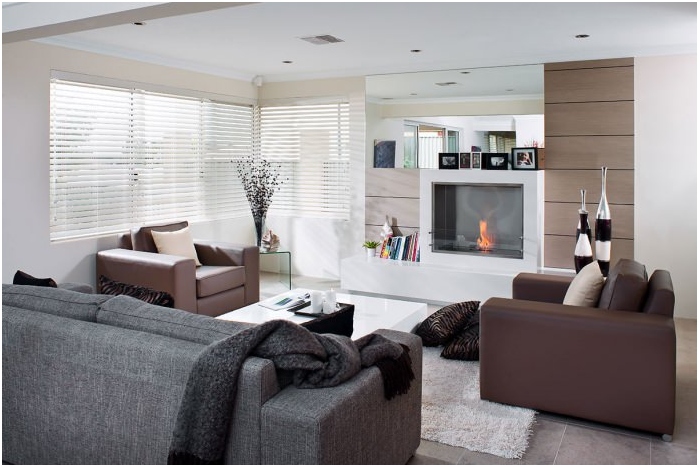
The main part of the fireplace is the burner, usually made in the form of a metal container. In different types of biofireplaces the burners are arranged differently. They can be equipped with a regulating cover, with which the flame is controlled, and also equipped with filters for air purification.
Ignition of fuel in the burner is carried out using a lighter of increased length or fireplace matches. The burner is inserted into a special slot in the body and can be either removable or non-removable. All materials used in the production of biofireplaces are subject to strict fire safety requirements: they must not ignite when heated.
The functional purpose of the biofireplace
The biofireplace in the interior performs several functions at once:
- room heating,
- interior decoration,
- aromatherapy.
The biofireplace copes with the heating function perfectly: in a room of 50 sq. m. it can raise the temperature by ten degrees. The design of the biofireplace allows it to become a real highlight in the interior of almost any style, which is widely used by designers. In addition, it can be used to saturate the room with vapors of aromatic oils, which is not only pleasant, but also useful..
The fuel used in bio fireplaces is considered environmentally friendly – that is, renewable. During combustion, carbon dioxide is released, and in the amount that plants absorb to produce biomass, from which fuel is obtained. On average, one liter of biofuel is required for two to four hours of burning a fireplace.
Advantages of a bio fireplace
Whatever the device of the biofireplace, it has undoubted advantages over conventional fireplaces:
- in the combustion process, biofuel is consumed, which, when burned, does not form toxic or polluting substances;
- when burning, no soot, dust is released, there are no extraneous odors, which makes its use very comfortable even in urban conditions;
- additional approvals from the fire supervision and other services are not required;
- the bio fireplace does not need a chimney, extractor hood or special ventilation system of the room;
- the device can be used in any room: apartment, office, restaurant, private house;
- care for the biofireplace is simple: it is only necessary to rinse it with water from time to time;
- if necessary, the biofireplace can be easily moved to any place, its weight does not exceed 105 kg for the heaviest models;
- the installation does not require special qualifications, it is only necessary to comply with fire safety standards;
- fuel supply does not require large expenses;
- suitable types of biofireplaces can be selected for each interior, which will not only warm, but also decorate the room with live fire;
- in the process of combustion, the formation of sparks is excluded, so you can admire a real flame without the risk of spoiling the atmosphere or causing a fire;
- the difference in size and design features will allow you to choose a biofireplace that is most suitable for a given room;
- the simplicity of the design allows you to build a biofireplace yourself and save on the purchase.
Disadvantages of biofireplace
There are few disadvantages of biofireplaces, but they still exist:
- fuel burning time is limited;
- the fireplace cannot be extinguished at any time, so it must be refueled based on the estimated operating time;
- the room heats up rather slowly;
- at the beginning of work, you can smell alcohol.
Types of biofireplaces
In order for the biofireplace to look the best in the interior, it is necessary to choose the right type of its design. They differ in their location:
- wall-mounted;
- tabletop – look like big candles;
- floor – they can be placed both near the wall and in the center of the room;
- built-in;
- biofuel – designed for embedding in other types of fireplaces, for example, in ordinary chimney ones in cases where it is not possible to clean the chimney or the use of firewood is impossible for some reason;
- plug-in;
- corner;
- fireplaces in the form of pieces of furniture, for example, a coffee table.
Those biofireplaces that are designed for wall mounting have fasteners. They are usually limited in size and cannot be more than a meter. The division into types can be based not only on the device of the biofireplace, but also on its shape, which can be both rectangular and round, and even curvilinear.
Usually fireplaces have a metal body covered with a polymer composition on top. The floor versions have legs for support – with their help, the height of the fireplace can be adjusted. There are even biofireplaces equipped with casters – they can be easily moved from place to place..
Fireplaces differ in size. The smallest, not exceeding half a meter, are candle fireplaces equipped with a stand. They are usually candle shaped, round or rectangular, and have a glass screen to protect against open flames. Floor-standing bio fireplaces can be very large and imitate the usual “smoky” fireplaces.
Bio fireplace in the interior
Whatever types of biofireplaces you choose, you need to take into account that they should not be used as the main source of heat. But for additional heating, especially in the off-season, such a fireplace is perfect. And yet, the main function of such a fireplace is not heating, but interior decoration..
The design of its appearance can be varied, which allows the bio fireplace to fit into the interiors of almost any style and direction. However, large floor-standing bio-fireplaces emit enough heat to heat a small room, even if there are no other heating devices in it, therefore mobile versions of such devices equipped with wheels are often used in summer country houses. Mini fireplaces in the form of candles are for interior decoration only.


